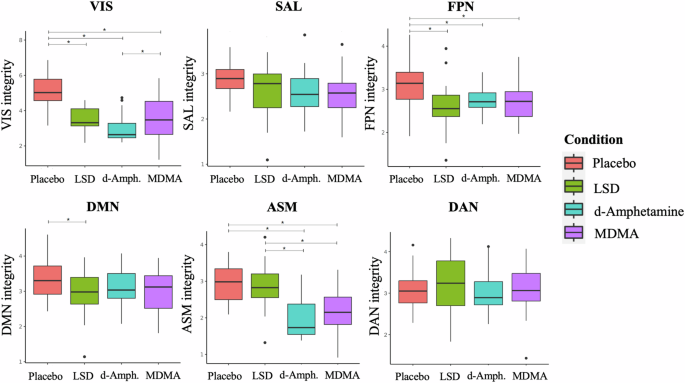服用麦角酰二乙胺、d-苯丙胺和 3,4-亚甲二氧基苯丙胺后大脑连通性的大规模变化
IF 9.6
1区 医学
Q1 BIOCHEMISTRY & MOLECULAR BIOLOGY
引用次数: 0
摘要
近来,迷幻药因其可减轻各种精神疾病相关症状而备受关注。然而,人们对产生这些作用的确切神经生物学机制仍然知之甚少。要深入了解其具体的作用机制,一种有价值的方法是将迷幻剂与具有部分重叠神经生理学效应(即调节相同的神经递质系统)的物质进行比较。成像数据来自 NCT03019822 临床试验,该试验探讨了麦角酰二乙胺(LSD)、d-苯丙胺和 3,4-亚甲二氧基甲基苯丙胺(MDMA)对 28 名健康志愿者的急性影响。临床试验采用了双盲、安慰剂对照、交叉设计。在这项研究中,对各种静息态连通性指标进行了检测,包括网络内连通性(完整性)、网络间连通性(分离性)、基于种子的静息态网络连通性和全局连通性。采用重复测量方差分析评估安慰剂和活性条件之间的差异,然后进行事后配对 t 检验。基于种子的体素连接性变化与血清素 2 A 受体密度图相关。与安慰剂相比,所有药物都降低了多个网络的完整性,这表明它们既有共同作用,也有独特作用。虽然迷幻剂独特地降低了默认模式网络(DMN)的完整性,但与我们的预期相反,安非他明降低了比迷幻剂更多网络的完整性。然而,迷幻药表现出了更明显的分离效应,其特征仅仅是减少,而安非他明则与之相反,也会引起增加。在所有物质中,网络之间基于种子的连通性大多会增加,而迷幻药比两种苯丙胺的效果更明显。最后,与安慰剂相比,虽然所有药物都会降低视觉区域的全局连通性,但迷幻剂特别增加了基底神经节和丘脑的全局连通性。这些发现加深了我们对迷幻药独特神经生物学效应的理解,促使我们进一步探索迷幻药的治疗潜力。本文章由计算机程序翻译,如有差异,请以英文原文为准。


Large-scale brain connectivity changes following the administration of lysergic acid diethylamide, d-amphetamine, and 3,4-methylenedioxyamphetamine
Psychedelics have recently attracted significant attention for their potential to mitigate symptoms associated with various psychiatric disorders. However, the precise neurobiological mechanisms responsible for these effects remain incompletely understood. A valuable approach to gaining insights into the specific mechanisms of action involves comparing psychedelics with substances that have partially overlapping neurophysiological effects, i.e., modulating the same neurotransmitter systems. Imaging data were obtained from the clinical trial NCT03019822, which explored the acute effects of lysergic acid diethylamide (LSD), d-amphetamine, and 3,4-methylenedioxymethamphetamine (MDMA) in 28 healthy volunteers. The clinical trial employed a double-blind, placebo-controlled, crossover design. Herein, various resting-state connectivity measures were examined, including within-network connectivity (integrity), between-network connectivity (segregation), seed-based connectivity of resting-state networks, and global connectivity. Differences between placebo and the active conditions were assessed using repeated-measures ANOVA, followed by post-hoc pairwise t-tests. Changes in voxel-wise seed-based connectivity were correlated with serotonin 2 A receptor density maps. Compared to placebo, all substances reduced integrity in several networks, indicating both common and unique effects. While LSD uniquely reduced integrity in the default-mode network (DMN), the amphetamines, in contrast to our expectations, reduced integrity in more networks than LSD. However, LSD exhibited more pronounced segregation effects, characterized solely by decreases, in contrast to the amphetamines, which also induced increases. Across all substances, seed-based connectivity mostly increased between networks, with LSD demonstrating more pronounced effects than both amphetamines. Finally, while all substances decreased global connectivity in visual areas, compared to placebo, LSD specifically increased global connectivity in the basal ganglia and thalamus. These findings advance our understanding of the distinctive neurobiological effects of psychedelics, prompting further exploration of their therapeutic potential.
求助全文
通过发布文献求助,成功后即可免费获取论文全文。
去求助
来源期刊

Molecular Psychiatry
医学-精神病学
CiteScore
20.50
自引率
4.50%
发文量
459
审稿时长
4-8 weeks
期刊介绍:
Molecular Psychiatry focuses on publishing research that aims to uncover the biological mechanisms behind psychiatric disorders and their treatment. The journal emphasizes studies that bridge pre-clinical and clinical research, covering cellular, molecular, integrative, clinical, imaging, and psychopharmacology levels.
 求助内容:
求助内容: 应助结果提醒方式:
应助结果提醒方式:


